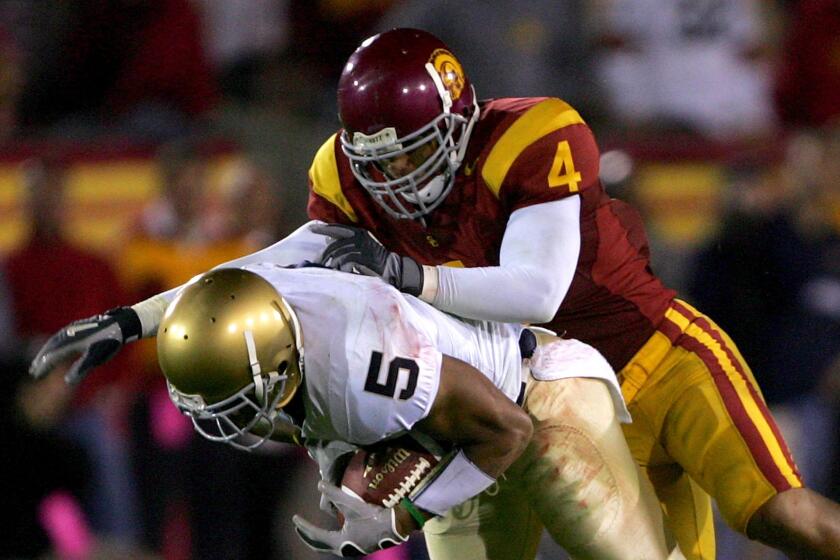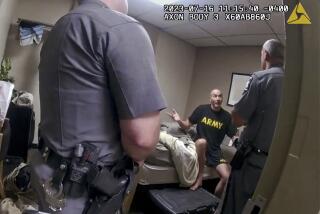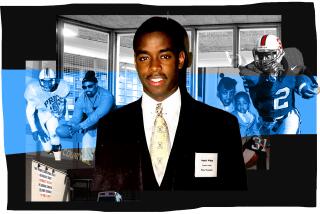A troubled ex-USC football star died at 31. His family hoped that studying his brain for CTE would help others

The brains arrive at all hours in white cardboard boxes stamped “RUSH!” Inside each package is an inch-and-a-half-thick foam liner and a red bag protecting an ordinary white plastic bucket.
When a courier service delivered Kevin Ellison’s brain to the Bedford VA Medical Center near Boston just after 2 p.m. on Jan. 22, Dr. Victor Alvarez performed the routine he has done so many times that he’s stopped counting.
The neuropathologist unpacked the box, weighed the brain and examined it for contusions or hemorrhages. He snapped dozens of pictures with various exposures to capture differences in shape and color not apparent to the naked eye.
Alvarez processes most of the brains donated to the partnership between the Department of Veterans Affairs, Boston University CTE Center and the Concussion Legacy Foundation. He moves with care and speed, knowing each brain represents a family searching for answers.
Ellison’s family donated his brain to be studied for CTE, or chronic traumatic encephalopathy, the devastating neurodegenerative disease found in people who have suffered repeated head trauma but can be diagnosed only after death. Football players are its most prominent victims.
It had been three months since Ellison died at age 31 — and nearly a decade since his days on the football field as a hard-hitting defensive back, team captain and fan favorite at USC. He went on to play one season for the San Diego Chargers. The three words tattooed on his left arm summed up his approach to life: “Be the best.”
Americans are enamored with violence, football provides plenty of it, and players will pay the price with brain trauma, Dylan Hernandez writes.
Ellison had been living in an apartment behind his mother’s home in Inglewood. He had earned an economics degree in college, but at the end he no longer drove and struggled to keep jobs. He had a headache that never really left. His neck hurt and he felt dizzy. He couldn’t sleep, heard voices, talked to the sky.
Sometimes the old Kevin returned, his mother recalled. But she could tell when the darkness approached. His grin faded. His eyes wandered. He took long showers to escape, the sound drifting into the living room.
The final journey of K-0623, as Ellison’s brain was known to researchers, passed through laboratories and cramped offices in Boston. The search for answers to Ellison’s unraveling took almost a year. Did football, which had given him joy and fame, contribute to his decline? His family would spend that time waiting for an answer.
At his memorial service, the program included a letter his mother, Judy Reisner, wrote to her son: “All my memories just reinforce how deep the relationship between a mother and child. So deep that during these last years, not only could I see the pain in your eyes, I could feel it. It hurt me to my bones that I couldn’t remove it.”
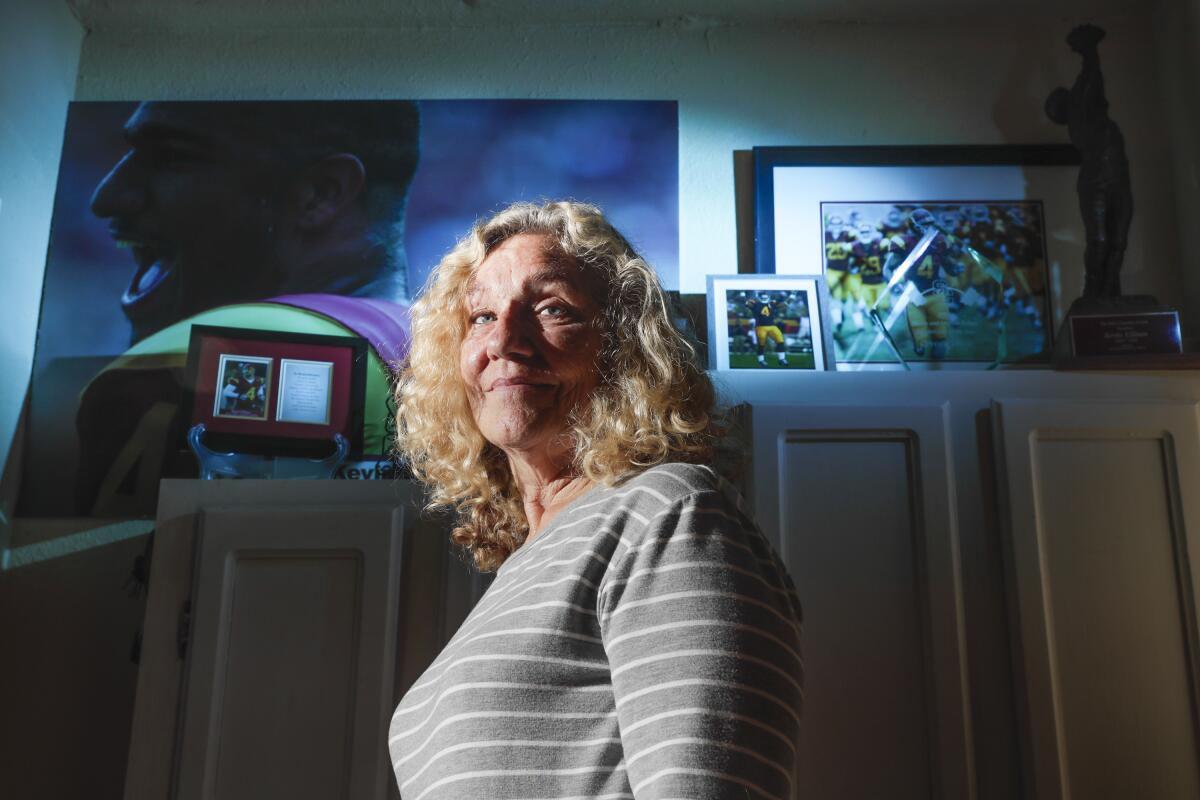
The family traced Ellison’s decline to the middle of 2012. After his NFL career faltered, he joined an Arena Football League team in Washington state. He had started drinking, something he avoided at USC, and took prescription painkillers. In his first game for the Spokane Shock in May 2012, he scored a touchdown.
Five weeks later, Ellison ignited the bed in his apartment at the Big Trout Lodge with a marijuana-filled cigar. He jumped out a third-story window, later telling authorities God ordered him to start the fire and would prevent anyone from being hurt.
Eventually transferred from jail to a psychiatric facility, Ellison was diagnosed with bipolar disorder and schizophrenia.
“He would reset. He would falter. He would be hospitalized,” Camille Ellison, his sister, said during his memorial service. “He would feel better. He would start a new job. He would have to quit. He couldn’t work long hours or drive because that required a considerable amount of concentration and his brain couldn’t handle it. Yet, oh, how his spirit wanted it.”
On Oct. 2, 2018, the family tried to persuade Ellison to go to a hospital for a 72-hour psychiatric hold. He hadn’t taken his psychiatric medication for weeks. The voices and paranoia returned.
Ellison ran down the street from his mother’s house, told a neighbor someone was trying to kill him and vanished. The family filed a missing person report, called hospitals and police departments. Two days later, Camille Ellison posted on Facebook: “If you happen to see my youngest brother, Kevin (i.e. most likely walking) can you please text me.”
An hour before midnight, a man wandered onto the northbound lanes of the 5 Freeway in the San Fernando Valley. He waved his arms at passing vehicles. Minutes after a motorist called 911, a Chevrolet Astro minivan hit the man. Paramedics pronounced him dead at 11:36 p.m. He carried a bus pass and wore a USC sweatshirt.
The Los Angeles County medical examiner-coroner identified Ellison through fingerprints.
Three days after the death, his eldest brother, Chris, received an unusual email.
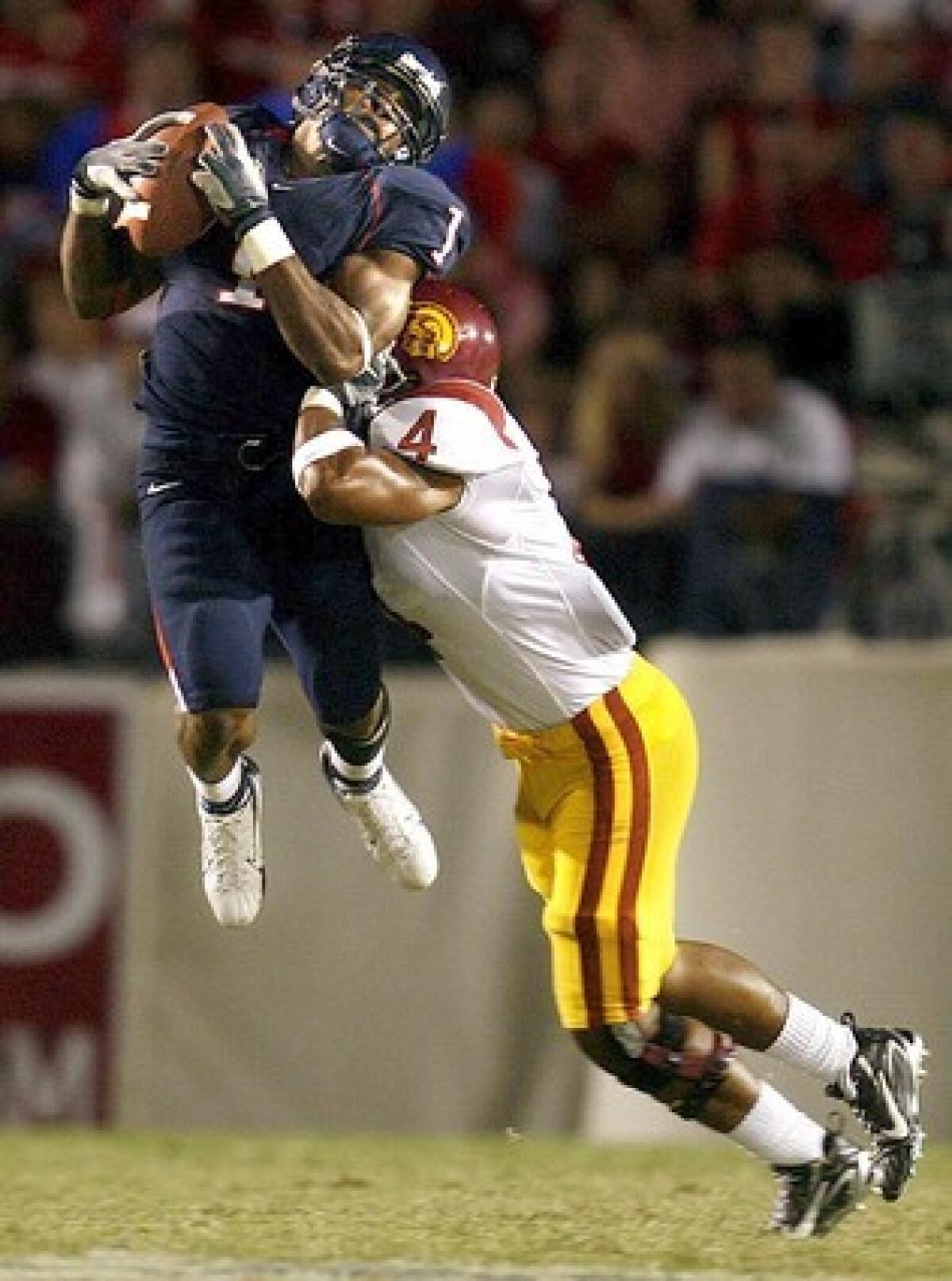
“I am terribly sorry to hear about your loss, and I am very sorry to reach out today,” Chris Nowinski, co-founder of the Boston-based Concussion Legacy Foundation, wrote. “I am emailing on behalf of the Boston University CTE Center, and we’d like to try and help your family.… If your family would like us to study Kevin’s brain, we may be able to provide you with a diagnosis that helps you better understand what happened.”
Chris Ellison responded a few minutes later: “I am certain this is something we would want to do.”
Nowinski, who played football at Harvard and wrestled professionally, has made such requests for more than a decade. The first came after former Philadelphia Eagles defensive back Andre Waters killed himself in 2006.
Nowinski wrote a script for what to say, then worried, sweated, procrastinated. Eventually, he called and asked the family for permission to study Waters’ remains for CTE. They agreed. Though Waters died at age 44, the examination found his brain had the characteristics of someone twice that age.
These days, Nowinski doesn’t need to send many emails. Word has spread. Families who want to donate brains from deceased loved ones call a black flip phone carried 24 hours a day by center research assistants. They have a few minutes to evaluate whether the brain would be suitable for study. There are more donated brains — from athletes, military veterans and others — than time to examine them.
Two hours after the email, Ellison’s mother signed the consent form. Reisner’s three boys all had suffered concussions. Keith, the middle brother, spent five seasons as a linebacker with the Buffalo Bills. Chris, who played defensive back for Brigham Young, works as an agent for several NFL players and hopefuls.
Kevin, the youngest, had told his sister that he had eight concussions. He had built a reputation for ferocious hits on the football field. Shortly after his death, the USC athletic department tweeted a 14-second video of Ellison hurling his body at California receiver DeSean Jackson in 2006. Their helmets smacked into each other. The announcer crowed about how Ellison almost “beheaded” Jackson.
“The late, great Kevin Ellison,” the tweet said.
At the memorial service, the Ellison family distributed bracelets inscribed with the dates of his birth and death as well as his nickname — Kells. Near flower arrangements with “Be the best” and “Loved by all” written on ribbons, Camille Ellison described her brother’s journey through the fog of mental illness.
“This beautiful human being,” she said. “Still smart, still competitive, handsome and a leader, stuck in a cycle where his brain kept failing him — even when he’d get back on his feet and good things started happening again for him.”
Ellison’s brain remained at the medical examiner-coroner’s office in L.A., stored inside a white plastic container filled with formalin — a pungent mixture of formaldehyde and water — for the trip to Boston.
The brains studied by Alvarez and other neuropathologists are processed at the Bedford facility or the Jamaica Plain VA Medical Center in Boston. In Jamaica Plain, a glass-door refrigerator is filled with white buckets holding brains, each container labeled with a case number. Industrial freezers filled with frozen brain halves occupy adjacent rooms.
About a decade ago, Alvarez drove through a snowstorm to surgically remove the brain of a former college football player who had agreed to donate his brain for study. The storm knocked out power to the building, so Alvarez ran an extension cord to a generator in a neighboring business. He brought the brain back to the lab and processed it without delay.
Brains fixed in formalin have a rubbery texture; fresh brains arrive packed in ice and feel like ripe brie. The fresh brains are halved. Part is stored in a minus-80 degree freezer for later genetic and molecular studies. The other is placed in preservative for several weeks to firm up and stop decay.
An hour or so after Ellison’s brain arrived, Chris Ellison received an email from one of the research assistants, Laney Evers.
“We understand that you may be anxious for the results so please know that we will do our best to ... work as efficiently as possible,” Evers wrote.
Given the number of brains to study, seven months passed before Alvarez dissected Ellison’s brain July 24, the same day most NFL players reported for training camp.
The brain is sectioned with a tool resembling a bread knife but with a nonserrated edge. Alvarez is known among colleagues for precise cuts, with a practiced and methodical technique. He begins with his left hand gently pressing on the top of the brain while his right hand slides the knife horizontally near the bottom. The goal is coronal slices about a third of an inch thick.
Each cut reveals a new piece of the puzzle. Has the frontal lobe shrunk? Are the ventricles enlarged? Alvarez places each one on a black sheet and photographs it.
Tissue from up to 40 areas of the brain is embedded into cassettes, inch-wide hinged plastic sleeves. The cassettes undergo a day of chemical processing, then paraffin wax is added to enhance the structural integrity of the tissue.
A histologist sections off pieces a tenth the thickness of a human hair. The sections are placed on 80 to 100 glass slides, each one stained by hand.
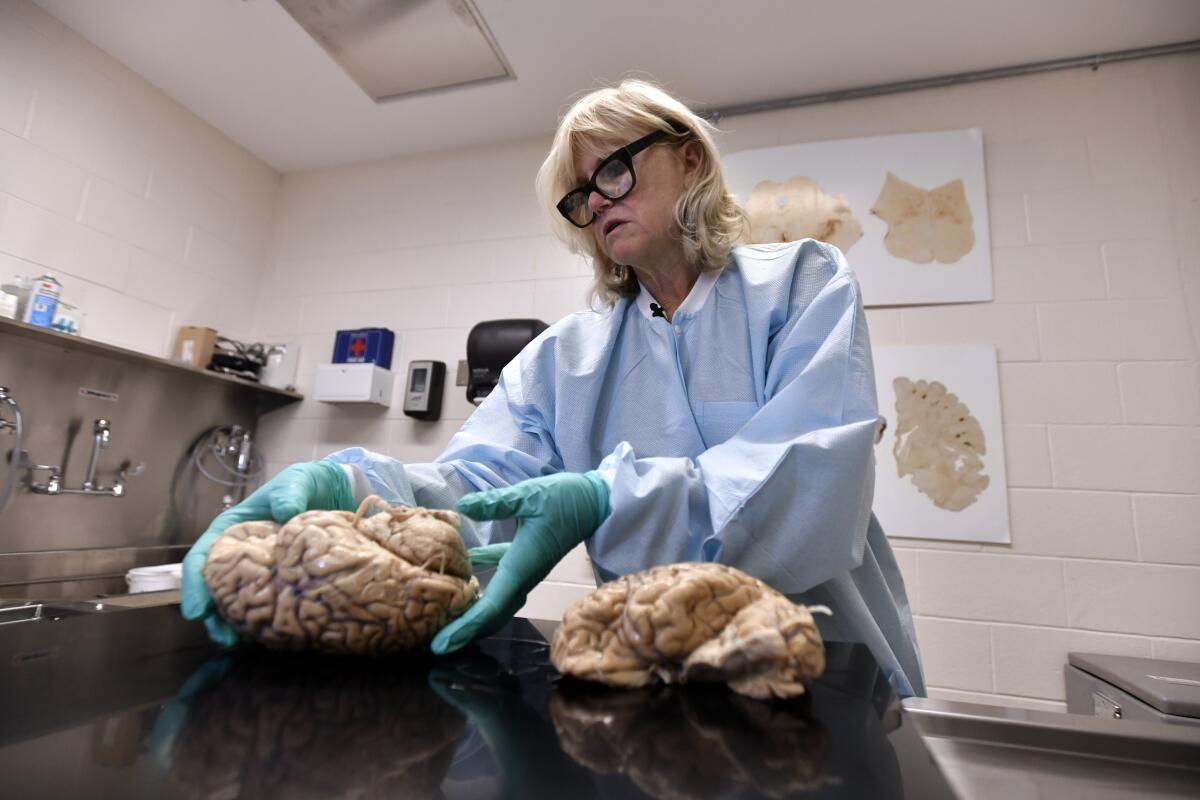
In late August, Kevin Ellison’s slides traveled to the 12th floor at the Jamaica Plain facility, down a white cinder-block hallway and into Dr. Ann McKee’s cramped office, where a wilted plant sits next to a large microscope. McKee is chief of neuropathology for the VA Boston Healthcare System and director of the Boston University CTE Center.
Piles of trays filled with 20 slides each crowd her desk and every other available surface. Two football helmets and a foam cheesehead, from her days rooting for the Green Bay Packers, are reminders of the tension between her pioneering research into CTE over the last decade and America’s most popular sport.
“I used to love football,” McKee said.
She would fight nerves and have sleeplessness nights before each Packers game. CTE changed everything.
“None of these people expected to be risking their brain health,” McKee said. “This was not in their plan. You know, they aren’t people that said, ‘Yeah, I want to play football so badly I don’t care if I can’t think straight.’ That was never part of the decision.”
She thinks of the slides as chapters in a book, each one providing another clue to the person and what they experienced. Though she has access to the name and age for each case, she doesn’t have any additional details in order to keep the focus on the story the slides tell.
A study published last year found CTE in the brains of 133 of 136 former pro football players, though the sample was drawn from donations — and families are more likely to donate the brains of loved ones who had experienced difficulties in life.
Her routine is the same for each set of slides. McKee starts with the olfactory bulb, responsible for the sense of smell, which hints at what she’ll find elsewhere. Dark tangles of tau protein — the toxic hallmark of CTE — are often visible.
Next she examines the substantia nigra, which helps control muscle movement, and the superior frontal cortex, an important area for executive function and emotions.
Each clue brings McKee closer to another answer for another grieving family.
“I feel like I need to be part of the awareness and advocacy because who else will do it?” McKee said. “Who will carry this torch? Who will make the difference for these families if they don’t have a spokesperson?”
Four days after she examined Ellison’s brain, his brother Keith was on the sidelines coordinating the defense as the Redondo Union High School football team scrimmaged against Arcadia High. His brother Chris coached the defensive backs.
‘Who will carry this torch? Who will make the difference for these families if they don’t have a spokesperson.’
— Dr. Ann McKee
While neuropathologists peered into Ellison’s brain, clinical researchers dug into his life. On Sept. 17, research assistant Madeline Uretsky called the family with a series of questions.
Uretsky, who suffered a serious concussion while playing high school soccer eight years ago, shares an office with other research assistants at the Boston University CTE Center. Miniature football helmets representing the 32 NFL teams are pinned to the wall, next to a framed photo of New England Patriots quarterback Tom Brady.
The researchers collect information using about 400 data points to build a narrative of a subject’s life. Ellison’s family had filled out initial electronic surveys in March and September, but now had more questions to answer:
What is the subject’s psychiatric and neurological history? Where did they work? Could they remember the day of the week? Did they misplace objects? Struggle with substance abuse? Have headaches?
Uretsky would hear about Ellison playing tackle football at age 8 with the Inglewood Jets. How he loved to eat, and as a child was caught in a closet methodically devouring a loaf of Wonder Bread. She learned how he graduated from high school a semester early to play for USC and about his return from three knee surgeries. She also learned about the time he bought 100 Vicodin pills on the street after his rookie season in the NFL to hide a knee injury from the Chargers.
And she would hear about the series of 72-hour psychiatric holds, the times he stopped taking medication because it left him lethargic and made him gain weight, and the attempts to self-medicate with marijuana and alcohol.
Twice a month, the Boston researchers hold a “consensus meeting” to discuss their findings, and on Sept. 24 they took up Ellison. Each case begins with a research assistant summarizing the family interview and other information gathered about a subject. The clinicians, including neurologists, neuropsychologists and psychiatrists, discuss the subject. The neuropathologist is last, illustrating the presentation with slides of brain tissue.
Though the clinicians know the subject’s identity while the research is being conducted, the name is withheld at that point from the staffers who process and examine the brain to avoid any unconscious bias. At the consensus meeting, the name comes out. When McKee isn’t presenting, she’ll sometimes Google the person being discussed as the meeting continues. She can’t restrain her curiosity.
The day after the meeting on Kevin Ellison’s brain, Judy Reisner dialed into a conference call with McKee. Camille Ellison did the same. The doctor thanked them for the donation and delivered the news quickly: Kevin had CTE.
The frontal lobe of his brain had atrophied and the lateral ventricles were enlarged. The changes don’t usually appear until a person is 50, 60, or even 70 years old.
Slides from the superior frontal cortex and inferior parietal region, magnified 40 times, revealed scores of brown specks — telltale CTE lesions. Other slides showed the same thing.
The interplay between CTE and Ellison’s mental health issues wasn’t clear. CTE can be mistaken for bipolar disorder and schizophrenia — Ellison experienced both — or be found at the same time as both conditions. McKee found “mild neurofibrillary degeneration” of the locus coeruleus, which is involved with the body’s response to stress.
For Reisner, the news wasn’t surprising. She had a gut feeling her son had CTE. She still cries each day. Now she worries about youngsters playing football.
“There’s an allure to football, people love watching it, people think these guys are demigods and they make a lot of money,” Reisner said. “But they need to be aware of what could happen to them.”
The day after the call, back in the Inglewood living room filled with photos of Ellison grinning — on the USC sideline, at graduation, with his nieces — Reisner watched the Philadelphia Eagles play the Packers on her big-screen television. Camille Ellison popped in for a minute. She saw Avonte Maddox, an Eagles player, carted off after taking a hit to the head. It made her feel sick.
“After living through what those unseen injuries, those head injuries, those brain injuries do to a person, it’s hard, it’s hard,” she said. “It prompts me to think, ‘OK, now that we know, how can we do better?’ We know CTE exists, it has a devastating impact on people and it had a devastating impact on my brother. … The game is safer, but it’s still not safe.”
The diagnosis hasn’t changed Chris Ellison’s view of football. He suffered several concussions during his playing career and figures he has CTE too.
“Hopefully it can help somebody else in the future,” Chris Ellison said of the research on his brother’s brain. “Kevin had a mental illness. And the CTE might have enhanced it in how he was able to process the mental illness, but that direct correlation, I don’t necessarily agree with.”
Five days after the conference call, Chris Ellison visited Pittsburgh to watch a client play as the Steelers faced the Cincinnati Bengals. It had been a difficult stretch. The anniversary of his brother’s death Oct. 4 was approaching.
Chris wanted to remain in control of his emotions, but as he drove through Pittsburgh, memories flooded back. He couldn’t stop the tears.
“He’s my little brother,” Chris said.
That week, seven more brains arrived in Boston to be studied for CTE.
More to Read
Get our high school sports newsletter
Prep Rally is devoted to the SoCal high school sports experience, bringing you scores, stories and a behind-the-scenes look at what makes prep sports so popular.
You may occasionally receive promotional content from the Los Angeles Times.
